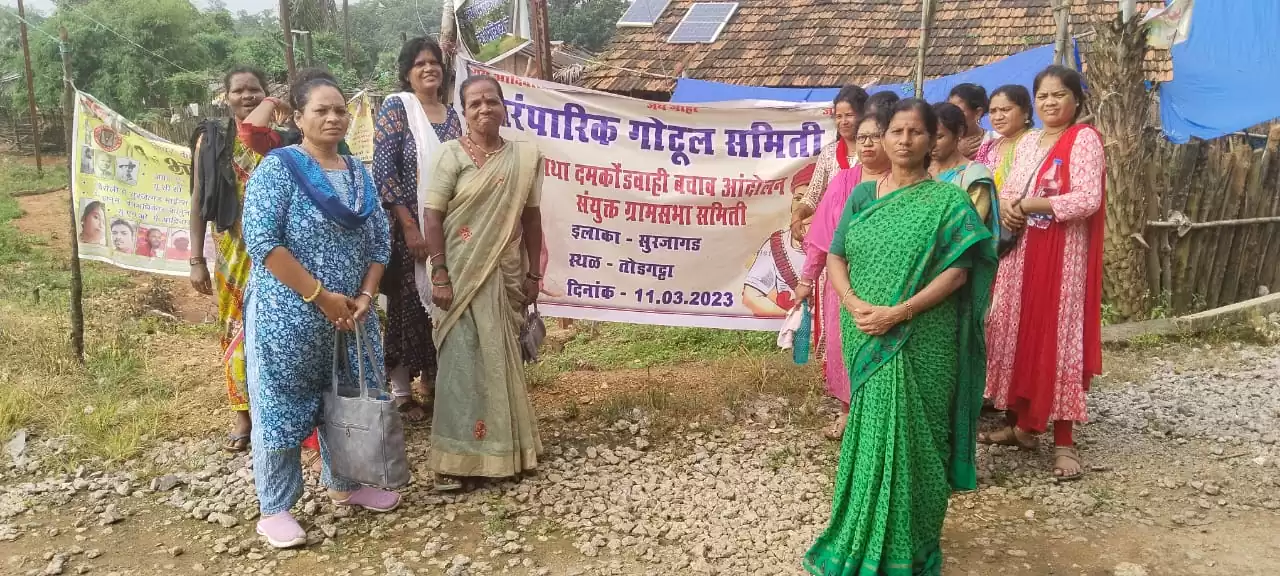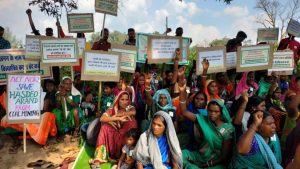Why The Adivasi Protest Against Mining In Gadchiroli Shows No Sign Of Flagging
Intensification of mining activity has upset the tribal groups for whom the Surjagarh Hill, forest and water bodies are sacred

On the Surjagarh Hill near Etapalli village of Gadchiroli district in eastern Maharashtra, a resistance movement has been on against iron ore mining by private companies for two decades now. Last week, in a crackdown by security forces, 21 activists were detained and later remanded to magisterial custody in Chandrapur. Those present at the venue said the activists had been mercilessly lathicharged as they were being removed from the site.
The Madia Gonds, a particularly vulnerable tribal group (PVTG) inhabiting the region where the mines are located, said they have vowed to protect its sacred hill, water, forest and land. Eight months ago, they had set up huts made of bamboo and straw in the midst of paddy fields and water bodies to mark their protest site at Todgatta.
There are photos of Birsa Munda, Savitribai Phule and Bhagat Singh marking the tribe’s resistance against the proposal to extend mining activity in six new mines in the region. The police have now claimed that the makeshift ‘deras’ or bamboo huts have been razed by residents fed up with the long-drawn stir by outsiders.
Protestors, banded together as the Damkondawahi Bachao Sangharsh Samiti, have been congregating at the site for the past 253 days. They are now demanding that those arrested be released while the police have requested an 8-day custody remand beginning on November 21.
A delegation consisting of advocate Lalsu Nogoti, the president of the Nari Mukti Manch Sushila Naroti, student leader Rakesh Alam, and activist and sarpanch Poonam Jetti, Vandu Uike and Sainu Hichami held a public meeting and press conference at the Press Club of India in New Delhi. The conference, titled “Anti-Displacement Movement and State Repression”, was organised by the Forum Against Corporatisation and Militarisation (FACAM).
A document, Report on Mining, Repression and Resistance, put together by the samiti and summarises the context of the campaign, was released during this event. Women activists led by Sushila Narote, who heads the campaign’s women’s collective, said that women in the area feel vulnerable to police violence and the “company folks who come and settle here”. Women, Behanbox had recently reported, are at the forefront of these resistance movements and in Odisha’s Rayagada district they too spoke of the fear of violence and harassment.
The activists do not have any access to the FIR against those arrested so far. But they said the remand sheet mentions section 353 of the Indian Penal Code alleged that the arrested activists “tried to hit and kill the police, have explosives in their possession, and are funded by Maoists”. They denied these charges.
The environment ministry has been consistently weakening mining regulations in India, as per environment analysts. In early 2022, the ministry loosened regulations to allow mining companies to increase production by up to 50% without holding public hearings. And more recently, the Mines and Minerals (Development and Regulation) Amendment Bill, 2023 cleared by the Parliament seeks to amend the Mines and Minerals (Development and Regulation) (MMDR) Act of 1957 with the primary goal of encouraging private sector participation in the exploration of essential and deep-seated minerals.
These moves have triggered protests. Indigenous communities have been protesting against mining by private companies across central India. In Odisha’s Rayagada district, protests began in February this year as business conglomerate Vedanta Limited won the bid to mine the Sijimali bauxite reserve.
‘It Was A Peaceful Protest’
According to a press note circulated by the samiti on WhatsApp, the police remand sheet says that the police intend to carry out intense interrogations in order to “uncover where and how they conspired in the related incident, capture the relevant evidence, expose the support being provided by Maoist organisations, and get information on future behaviour of the accused in connection with their severe crime of planting explosives and associating with Maoist organisations”.
Refuting the charges, the Damkondawahi Bachao Sangharsh Samiti stated that the claims are being fabricated by the police in order to suppress the protest.
“Our peaceful protest was ongoing, activists were brutally thrashed and picked up and taken away into detention via a helicopter. There were no questions asked. We were lathicharged and told that we are Naxals,” said Dilesh Gawde, who was participating in the protest. “It’s been over two days but our fellow activists have not returned. We are demanding the protection of our jal, jangal and zameen.”
As per the Report on Mining, Repression and Resistance, Etapalli and other neighbouring tehsils such as Surjagarh, Bande, Damkondawahi, Besewada, Vadavi, Korchi have large, lucrative deposits of coal, granite, copper, zinc, quartz, dolomite, and mica. In 2005, the report adds, 25 mining projects were proposed in the Gadchiroli district and of these, Lloyds Metals and Energy Private Limited (LMEL) was given the clearance to begin mining iron over 348.09 hectares in Surjagarh in 2007 for 50 years.
The entire lease area falls in the Bhamragarh Reserve Forest, and activists state that no public consultation process was conducted for this and despite the resistance, mining activity began in 2011. Over the years the extensive mining in the region has led to the discharge of red iron oxide discharge and chemical effluents into water bodies. The fresh water in the region has reportedly turned red and is unusable and agricultural fields are overrun by silt.
Extension of Mining Work
Protests began in March this year against extension of mining activity in the region that had begun in 2011. The environment granted LMEL the clearance to excavate up to 10 Million MTPA (metric tonnes per annum) of iron ore, over three times up from the earlier 3 Million MTPA. Additionally, the company was allowed to build a crushing and processing plant each in Aidri, Malampadi and Bande villages.
Moreover, in June this year, six more mines were leased to five private companies through a composite mining lease in an area spanning 4,684 hectares. All six – the Omsairam Steels and Alloys Private Limited, JSW Steels Limited, Sunflag Iron and Steel Company Limited, Universal Industrial Equipment and Technical Services Private Limited, and Natural Resources Energy Private Limited – encroach upon the land for which community forest rights have already been granted to people from surrounding Adivasi villages under the Forest Rights Act, 2006, says the samiti report.
At least 40,900 people will be displaced if these mines come into existence.
“We wanted to talk openly to the government, instead there was a crackdown,” said Lalsu Nagoti. “We have been fighting against mining in the region since 2005 alongside the gram sabhas. From 2014 PESA rules came into place which meant that our movement picked up pace and was given further impetus. From the past two years resistance has been ongoing.”
The region comes under the fifth schedule and the provisions of the Panchayats (Extension to Scheduled Areas) Act, 1996 or PESA ensuring self-governance through traditional gram sabhas for people living in the country’s Scheduled Areas. Under its provisions, the gram sabhas must be consulted before approving and allocating mining and other development projects.
Advocate Nagoti said that this provision was ignored in Surjagarh. The report, released by FACAM, alleged misconduct during public hearings. “In October 2022, public consultation for the Lloyd’s mine’s expansion and crushing plant took place at Gadchiroli city, which was inaccessible to those affected by the project. Just before the consultation, buses full of people who had allegedly been bribed by the company, arrived. Such people, who villagers say had turned up intoxicated, took over the venue. The police prevented movement leaders from entering the consultation area. Thus none of the gram sabhas in Surjagarh Patti – the area which would actually face the impact – were consulted.”
Forest Rights Assigned, Ignored
Community forest rights are granted to indigenous communities over common forest land within the traditional or customary boundaries of the village or seasonal use of landscape. Activists stated that when CFR was granted to the villages on the sides of the Surjagarh mountain the local residents were not made a part of the consultative process, leaving the region vulnerable to mining.
Even when 13 villages were granted CFR it was done in a way that excluded the region where mining activities were planned. Essentially, even while recognising CFR they were able to continue mining.
People alleged, as per the samiti report, that they were not informed about their boundaries, and in many cases community members were not able to understand the technical notation language used to describe the boundaries. There is a process for contesting allocated CFR titles but it is long and arduous, allowing time for the environmental and forest clearances needed by mining companies.
The forest which is a means of sustenance for the community is also home to the Devon ke dev (god of Gods) Ohdal, or Thakurdeo, who is believed to reside atop the Surjagarh hill, the epicentre of mining in the region. A three-day yatra is carried out every year in January to the hill-top and the procession is joined by no less than 15,000 Adivasis across Maharashtra and neighbouring Chhattisgarh.
“However, since the mining activity has begun in the region tribals are no longer able to access the deity,” says Nagoti.
Militarisation and Maoism
The Gadchiroli region of Maharashtra that borders Chhattisgarh has witnessed frequent violent conflict between security forces and alleged Naxal groups. According to a 2021 review by the Ministry of Home Affairs, it is among the 25 districts in the country most affected by left-wing-extremism.
Mining activity in the region has also witnessed violent opposition from maoists. In 2013, Jaspal Singh Dhillon,vice-president (mines) at Lloyd Steel, Mallikarjun Reddy, proprietor of Hemlata Minerals which mines for Lloyd, and Raju Sadmake,the police warden of the Surjagarh prison were killed by Maoists. In 2016, 75 trucks of the Lloyd group were torched. Since then, mining has been intermittent here, with heavy police cover and the threat of more attacks.
The increased presence of security poses an increased security risk to the lives of women, say activists. A Nari Mukti Samiti led by Sushila Narote has been created in the region to highlight this. They have stressed that women face greater vulnerability from “outsiders”.
Speaking to Behanbox, Narote said: “Our lives are dependent on jungles and this is our fight. We felt that by collectivising we will be able to resist mining in the region and fight for our rights.”
Students who have been participating in the movement have also faced police violence. A student leader of the Adivasi Yuva Chatra Sangathan, Rakesh Aalam, 25, asserted his right to protest. “I am not a terrorist, I am not a Naxal and I am not an extremist. I am a citizen of this country fighting for my land and my community, the Adivasis” he said. “I have been working around these 70 villages. Our saathis were beaten up and we are demanding their immediate release.”
We believe everyone deserves equal access to accurate news. Support from our readers enables us to keep our journalism open and free for everyone, all over the world.


